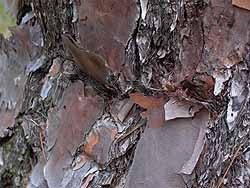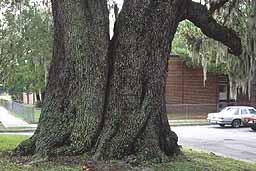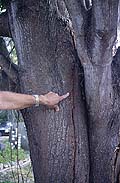Home > Tree structure basics > Cracks in the trunk
Cracks in the trunk
Wind or gravity can cause trees to bend past its elastic point which can separate wood fibers. The separation can result in a crack. Cracks in the trunk or main branches caused by mechanical loading can be a sign of weakness inside. Wood with cracks is more prone to failure than sound wood.
Transverse cracks (left and right photos) can form across the grain. Longitudinal cracks can form on the underside of trunks and branches from drought. Longitudinal cracks can result from trunk twisting (photo below-center). Bark inclusions are also cracks (photo below-left). See: more on cracks.
 The transverse crack or inclusion shown above formed when the trunk bent. The crack resulted when wood fibers collapsed inward.  The bark inclusion between these two trunks represents a crack from the ground to the top of the union. There is no mechanical connection between these two trunks. |
 Longitudinal cracks from twisting.
|


